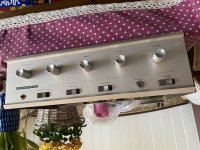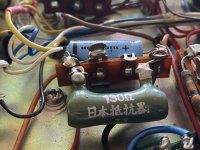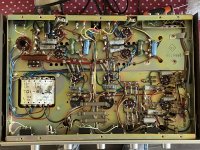I picked up this absolutely pristine Lafayette LA-224B integrated amplifier. It's a 15W push pull from the mid-60s.
It's apparently in fully working order, but I assume the electrolytics need replacement. However, what about the non-polarized caps? They don't look like the old style paper caps -- can I leave them be?
I would prefer to disturb the innards as little as possible, but I don't want to blow my OT either..
Aw, just look at that interior! Isn't is beautiful? Even my wife loved it! 🙂
It's apparently in fully working order, but I assume the electrolytics need replacement. However, what about the non-polarized caps? They don't look like the old style paper caps -- can I leave them be?
I would prefer to disturb the innards as little as possible, but I don't want to blow my OT either..
Aw, just look at that interior! Isn't is beautiful? Even my wife loved it! 🙂
Attachments
I assume the electrolytics need replacement. However, what about the non-polarized caps? They don't look like the old style paper caps -- can I leave them be?
All of the gray caps, which are paper in oil, should be replaced. They have a reputation for failure. This is considered standard procedure when restoring Japanese tube gear from this period.
I'm not sure why Japanese PIOs fail while PIOs made elsewhere are reliable, but they do fail. The question is not will they fail but when.
If you want to keep the same type of construction try some of the Russian K40Y-9 PIO caps as replacements.
Definitely replace the blue electrolytic caps. It's also wise to measure the resistors while you're working on things. Old resistors can drift substantially.
All of the gray caps, which are paper in oil, should be replaced. They have a reputation for failure. This is considered standard procedure when restoring Japanese tube gear from this period.
I'm not sure why Japanese PIOs fail while PIOs made elsewhere are reliable, but they do fail. The question is not will they fail but when.
If you want to keep the same type of construction try some of the Russian K40Y-9 PIO caps as replacements.
The presence or absence of hermetic sealing is a key point about PIO capacitors. Soviet surplus K40s, like U.S. made Vit. Qs, Gudeman, etc., are hermetically sealed. Hermetic sealing stops leaking, both mechanical and electrical. Out with the Japanese PIO caps. and in with the Russian parts.
It's apparently in fully working order, but I assume the electrolytics need replacement. However, what about the non-polarized caps? They don't look like the old style paper caps -- can I leave them be?
🙂
From that photo, I count 13 under-chassis capacitors that certainly need replacement (not including the top-chassis filters which also should be replaced).
Anything less is not an option if you want the best performance and reliability from that amp.
Yes.. I have ordered replacements for all just in case, but the PIO will be replaced with MKP then. Expensive NOS parts.. I have to admit I'm skeptical. Maybe some other time.
Would love to test out the amp before I do it, though. All tubes are original, and it has been playing music before I got it. Should I dare power it up, or is it just too risky?
Would love to test out the amp before I do it, though. All tubes are original, and it has been playing music before I got it. Should I dare power it up, or is it just too risky?
Yes.. I have ordered replacements for all just in case, but the PIO will be replaced with MKP then. Expensive NOS parts.. I have to admit I'm skeptical. Maybe some other time.
Would love to test out the amp before I do it, though. All tubes are original, and it has been playing music before I got it. Should I dare power it up, or is it just too risky?
Please, please, no metalized polypropylene (MKP) caps. as replacements for the PIO OEM parts. At a minimum, use 716P series Orange Drop film and foil parts.
Also, you can take Jim McShane's advice and use a mix of 716P and K40 capacitors, to hear the amp and not the capacitors.
Looks like a 110V transformer primary.
What are your power mains voltage? 110V, 120V, etc.?
If it was working very recently that is one thing.
The risk of all modifications (including just replacing all parts), is that it might not be working when all the parts are replaced.
Normally, I say make sure it is working, before doing modifications (such as parts replacement).
But old leaky coupling capacitors cause grid current, and high plate current, old electrolytic caps can be leaky, and cause problems.
Toss a coin, its 50/50, see if it still works before replacing parts, or just go ahead and replace the parts (very carefully).
Happy restoration, and happy listening.
What are your power mains voltage? 110V, 120V, etc.?
If it was working very recently that is one thing.
The risk of all modifications (including just replacing all parts), is that it might not be working when all the parts are replaced.
Normally, I say make sure it is working, before doing modifications (such as parts replacement).
But old leaky coupling capacitors cause grid current, and high plate current, old electrolytic caps can be leaky, and cause problems.
Toss a coin, its 50/50, see if it still works before replacing parts, or just go ahead and replace the parts (very carefully).
Happy restoration, and happy listening.
Is there much difference between foil and film and metallized film?
Had a look at my order, and I ended up with a mix of C0G and metallized foil, like this one here: https://no.mouser.com/ProductDetail/panasonic/ecw-f6203jlb/?qs=GoZnPdyRfja6UiiKTJFhWw==
The ceramics were simply because it was difficult to find film with low enough capacitance (combined with high enough voltage).
Are there any new parts series easily available you could recommend instead?
Had a look at my order, and I ended up with a mix of C0G and metallized foil, like this one here: https://no.mouser.com/ProductDetail/panasonic/ecw-f6203jlb/?qs=GoZnPdyRfja6UiiKTJFhWw==
The ceramics were simply because it was difficult to find film with low enough capacitance (combined with high enough voltage).
Are there any new parts series easily available you could recommend instead?
Last edited:
Looks like a 110V transformer primary.
What are your power mains voltage? 110V, 120V, etc.?
It's 240V here. The unit has a switch for 110 and 220. Previous owner lives not far away from me, so he has used it on 230 or 240V.
Please, please, no metalized polypropylene (MKP) caps. as replacements for the PIO OEM parts. At a minimum, use 716P series Orange Drop film and foil parts.
Also, you can take Jim McShane's advice and use a mix of 716P and K40 capacitors, to hear the amp and not the capacitors.
At close to zero current flow, as in coupling capacitors, film and foil types don't have any advantage over metallized film capacitors. And those mylar 716P's aren't bad at all, but surely are of no advantage over polypropylene caps.
Best regards!
Don't forget, after servicing, initial testing, select and short the aux inputs, turn the bass full up, and adjust the hum pots on the rear for minimum hum.
Then do the same for the mag phono inputs.
Then do the same for the mag phono inputs.
Kay,
Far too many observers prefer the 716P series discrete polypropylene film and aluminum foil over the metalized MKP stuff for it to be accidental. Low current or not, better pulse performance seems to matter.
FWIW, when a substantial capacitance is required in feeding the IHF "standard" 10 Kohm load, I like a 4.7 μF. MKP part bypassed by a 0.47 μF. 716P. I like to think I get the best overall compromise between the various factors, that way.
Far too many observers prefer the 716P series discrete polypropylene film and aluminum foil over the metalized MKP stuff for it to be accidental. Low current or not, better pulse performance seems to matter.
FWIW, when a substantial capacitance is required in feeding the IHF "standard" 10 Kohm load, I like a 4.7 μF. MKP part bypassed by a 0.47 μF. 716P. I like to think I get the best overall compromise between the various factors, that way.
Agreed about the .02 uf plate caps. Lafayette was a bargain brand from Allied Radio. Respect the chassis tubes & transformers, not the internals. There were more reliable paper caps like GI black wax dip and Goodall, and these weren't them. The carbon comp resistors are not even Allen Bradley or Sprague mil spec clones. Ie the dark brown resistors that after 1961 had paint that kept the humidity out on Navy ships etc.
I have receiver type tubes that are 60 years old and are fine. Rectifier tubes wear out in 4000-8000 hours, output tubes wear out in 8000-10000 hours unless red plated (guitar amps).
I have receiver type tubes that are 60 years old and are fine. Rectifier tubes wear out in 4000-8000 hours, output tubes wear out in 8000-10000 hours unless red plated (guitar amps).
This amplifier was made about 1965, and originally cost around $49.95
Reasonable re-capping is is a sensible option, but nitpicking and being overly obsessed over what damn brand/type of caps to use is goofy talk.
My opinion...
It's a standard budget amp, common design, and still is.
You can't make a mountain out of a mole hill, no matter if you use "high end" paper/oil fancy caps.
Nonsense talk.
Reasonable re-capping is is a sensible option, but nitpicking and being overly obsessed over what damn brand/type of caps to use is goofy talk.
My opinion...
It's a standard budget amp, common design, and still is.
You can't make a mountain out of a mole hill, no matter if you use "high end" paper/oil fancy caps.
Nonsense talk.
You can't make a mountain out of a mole hill, no matter if you use "high end" paper/oil fancy caps.
Agree, in general, but the Soviet surplus K40s remain relatively reasonable in cost. IMO, it's hard to argue with good stuff that doesn't trigger bankruptcy.
I don't care which "guru" blessed them, if PIO caps. lack hermetic seals pass them by. Tobias Jensen comes to mind, as they sound fine, until the leaking starts. 😡
This amplifier was made about 1965, and originally cost around $49.95
That's about $400 now. Imagine getting a hand-built, all-metal integrated tube amp (tubes included!) for that price today. In itself, that tells a story. Japan must have had insanely low cost labour back then? Or how did they manage it?
You can't make a mountain out of a mole hill
Hey, watch it buddy! You're talking about my girl here!
@Eli: I don't want to be the guy that buys a mint vintage piece, proceeding to rip its guts out and replace it with whatever YouTube says is da bestest. I want to preserve it, and I want it to sound good. It will be my home office amp, connected to a DAC, and, somewhere down the line, a record changer and maybe a cassette player.
With regards to Wima caps, I can't find higher than 250V at small capacitances.
I'll double check with the previous owner - if he has used the amp regularly up until now without issues, I'll test it out while waiting for parts. The original "LaFayette" tubes (Toshiba) are still in there, so it has been cared very well for.
If I monitor the grid voltages and they are within spec, could I still use it for a little while before recapping? I assume the caps fail gradually?
- Home
- Amplifiers
- Tubes / Valves
- Old tube amp - do non-electrolytics need replacement?


